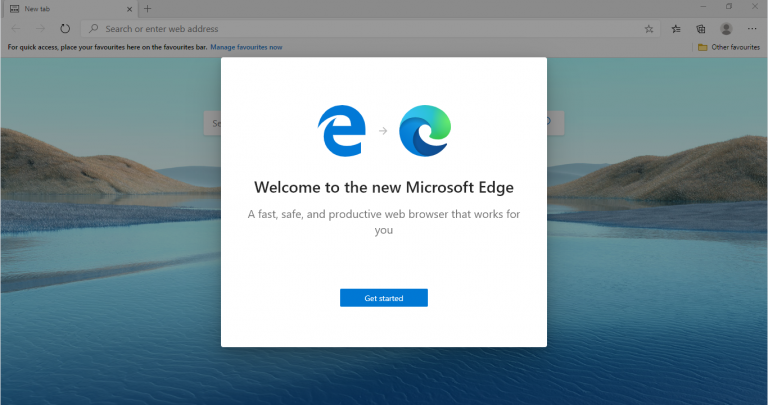
Microsoft seems not to be backing off, on the browser war. The company’s first attempt, Internet explorer, was released in 1995, and eventually became the most popular browser, peaking at 95% market share in 2003. In a bid to dominate the market further, it made it difficult for users to use other browsers in Windows. This led to a successful antitrust suit against the company. After that, Microsoft did not make much improvement to the browser, and gave other browsers like Chrome and Firefox a bigger chance to grow.
The second browser’s attempt, Edge, was released in 2015. It was only available for Windows 10. Yet, the old problem still persists. It was slow, and lacked many features that people really wanted. Unfortunately, it failed again, and boosted Chrome’s market dominance. By the end of 2019, Chrome had 69% of the worldwide desktop browser market, compared to 4.6% for Edge.
Now, there is a third attempt. The new Edge browser is here already. On June 3, 2020, Microsoft began rolling out to all Windows 10 users, via Windows update. This new browser represents a significant leapfrog from the company’s past. Instead of building the browser with proprietary code (Edge’s EdgeHTML), it has chosen to use the open-source Chromium source code, originally developed by Google. This same source code is used by browsers such as Opera, Brave. Unlike previous Microsoft CEOs, Satya Nadella, has been willing to break away from the orthodoxy of “go-it-alone-and-dominate-the-market vision”.
Register for Tekedia Mini-MBA edition 19 (Feb 9 – May 2, 2026): big discounts for early bird.
Tekedia AI in Business Masterclass opens registrations.
Join Tekedia Capital Syndicate and co-invest in great global startups.
Register for Tekedia AI Lab: From Technical Design to Deployment (next edition begins Jan 24 2026).
While the new Edge and Chrome, are now pretty similar, there are still some notable differences. Edge does not suffer latency, like chrome, especially when you keep multiple tabs in use. It is faster and consumes less memory. It is also taking a step forward to boost privacy. It offers a feature called tracking prevention, which blocks ad providers from tracking you from website to website. This makes it more challenging for companies like Google and Facebook, whose business model is built on tracking users’ activity.
The new Edge has abandoned many of the old Edge features and has onboarded new ones. Setting it up is very fast, and it gives you the choice of importing your favourites, passwords, browsing history, etc, from Chrome and other browsers directly. Unlike the old Edge browser, the new Edge works with Windows 7, Windows 8.1 and macOS, in addition to Windows 10. No more dozens of headlines from Microsoft’s news service, except you select the “informational” layout. The new Edge also supports Progressive Web Apps. You can download your favourite website as an HTML-based web app, and run it without having to run Edge itself.
Microsoft is indeed breaking away from its legacy culture. It is taking an “if you can’t beat them, join them” approach. Since its first browser, it has had difficulties in attracting developers to write extensions for its browsers. While Chrome and Firefox have thousands of extensions, for almost everything imaginable, the old Edge has just about 300 extensions, five years after it was released. That will no longer be a problem. The Chromium-based Edge browser has been built to work with Google’s existing extension, in addition to Microsoft’s curated Edge extensions. A user can easily go to Chrome Web Store, download and install the Google extensions needed. This is a big lesson for entrepreneurs and product managers. Many times, you don’t have to reinvent the wheel.
No doubt, the browser war is getting tougher, especially against Chrome’s dominance. Other competing browsers are leveraging the small advantage they can. Recently, Brave’s browser just surpassed 15 million active users. For those who don’t know about Brave, Brave is a privacy-focused web browser that shares its advertising revenues with users. It comes with a built-in digital wallet for its native cryptocurrency, the Basic Attention Token (BAT). For users who opt-in to view ads, Brave will pay out up to 70% of its revenue by depositing BAT in their browser wallets. From there, users can exchange their BAT for other cryptocurrencies like bitcoins (BTC), Ethereum (ETH). As it scales, it will definitely challenge Google’s dominance. For a quick reminder, Google and Facebook track users’ online activity, collect their behavioural data and sell that data to the highest bidder. They receive 100% of the advertising revenues from that sale, while users receive nothing. Now, imagine what happens when people realize that they can get the same browsing experience (even better), without giving up their privacy and still get paid for it.
In all, Microsoft new Edge, Brave, Opera, all built on open source Chromium (by Google) are gearing to challenge Chrome’s dominance. Google is not relaxing as well. Last year August, it announced a new initiative, Privacy Sandbox, to improve the security and privacy of users. While this is a good move, the challenge still remains that it will be difficult for them to kick against their tracking habit. Tracking users is essential to their business model and at the core of their shareholder value proposition. It will be interesting to see how things play out in coming months. In the meantime, Welcome Chromium Edge!



Thank you for this informative post.